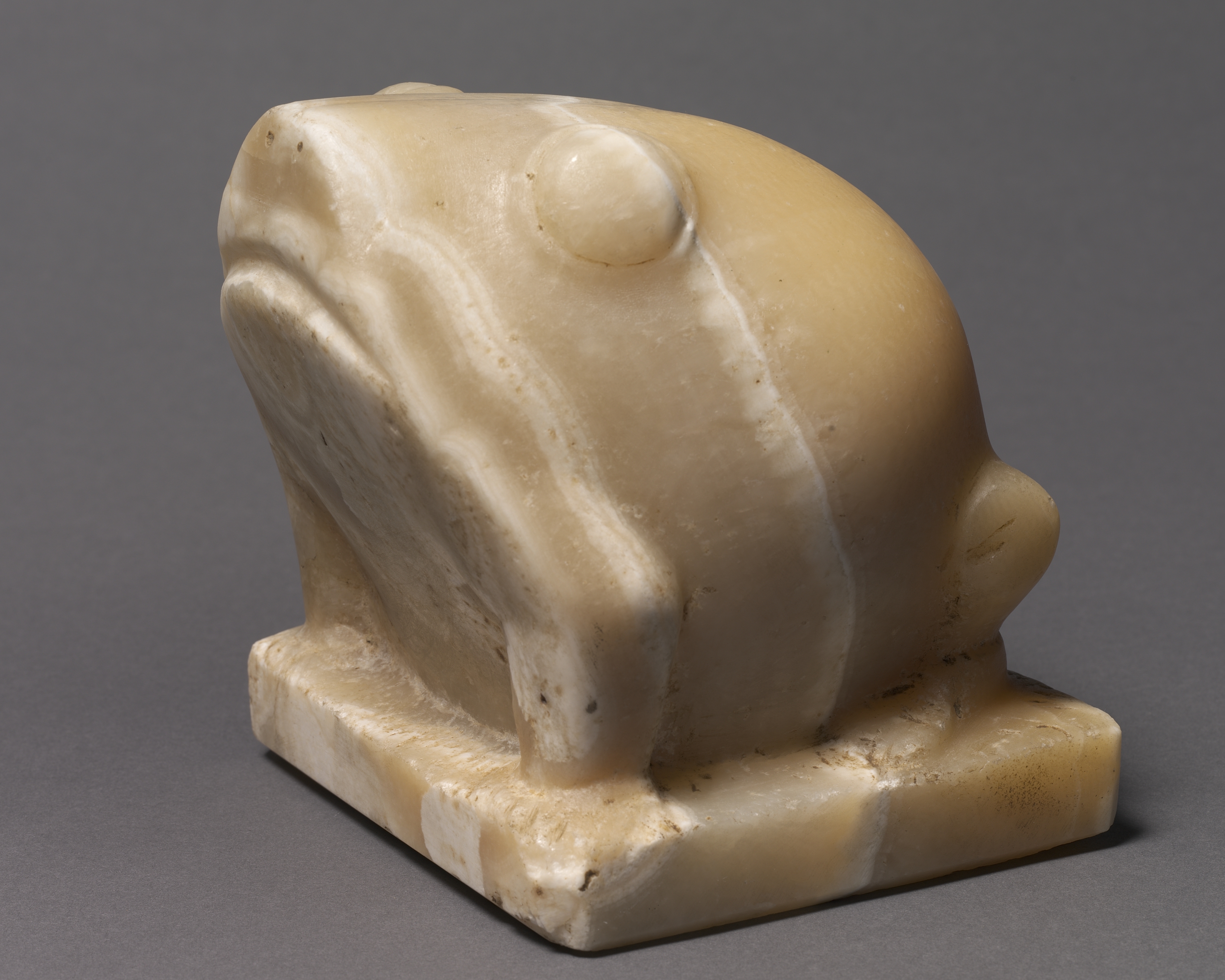The Cleveland Museum of Art
Collection Online as of May 7, 2024

Statue of Heqat, the Frog Goddess
c. 2950 BCE
(5000–2950 BCE), Naqada III (3200–3000 BCE)–Egypt, Early Dynastic (2950–2647 BCE)
Overall: 15.4 x 14.7 x 15.5 cm (6 1/16 x 5 13/16 x 6 1/8 in.)
Location: 107 Egyptian
Did You Know?
This probably represents a puffed-up Bufo viridis, one of two types of "frogs" (it is actually a toad) represented in Egyptian art.Description
During the Predynastic period statues of animals are much more common than those of humans. This statue of a frog stands at the beginning of a great tradition of animal sculpture in Egyptian art. The sculptor has shown great sensitivity to the natural banding of the stone, using it to enhance the roundness of the animal's form. Small frogs, mostly of faience, are among the most common votive offerings deposited at early temple sites. The frog's exact religious significance in the Predynastic period is unknown, but in later times it was most often identified with Heqat, the goddess who assisted at childbirth.- -1976(Bruce and Ingrid McAlpine, London, England, sold to the Cleveland Museum of Art)1976-The Cleveland Museum of Art, Cleveland, OH
- Cooney, John D. “An Early Dynastic Statue of the Goddess Heqat.” The Bulletin of the Cleveland Museum of Art 63, no. 7 (1976). pp. 202-209 www.jstor.orgLee, Sherman E. “The Year in Review for 1976.” The Bulletin of the Cleveland Museum of Art 64, no. 2 (1977). no.2 www.jstor.orgLa Chronique des Arts, supplement a la Gazette des Beaux-Arts 89, no. 1298 (March 1977) p. 38, fig. 155The Cleveland Museum of Art. Handbook of the Cleveland Museum of Art/1978. Cleveland, OH: The Cleveland Museum of Art, 1978. Reproduced: p. 12 archive.orgKathman, Barbara A. A Cleveland Bestiary. Cleveland, OH; Cleveland Museum of Art, 1981. Reproduced: p. 14; Mentioned: p. 13, p. 60Cleveland Museum of Art, and Adele Z. Silver. Guide to the Galleries. Cleveland, Ohio: Cleveland Museum of Art, 1981. p. 7, fig. 6Kozloff, Arielle P. "The Egyptian Collection of the Cleveland Museum of Art,: Newsletter of the American Research Center in Egypt 125 (Spring 1984). p. 10Wildung, Dietrich, and Jean-Baptiste Scherrer. L'Égypte: traduit de l'allemand par Jean-Baptiste Scherrer. Paris: Citadelles, 1989. color pl. 4Cleveland Museum of Art, and Arielle P. Kozloff. An Introduction to the Art of Egypt in the Cleveland Museum of Art. [Cleveland]: [The Museum], 1970. p. 3Berman, Lawrence M. "La Collection Egyptienne du Cleveland museum of Art," BSFE 134 (October 1995).
p. 25, fig. 7Berman, Lawrence M., and Kenneth J. Bohač. Catalogue of Egyptian Art: The Cleveland Museum of Art. Cleveland, OH: Cleveland Museum of Art, 1999 Reproduced: p. 79-80, color p. 41; Mentioned: p. 79-81 - A Cleveland Bestiary. The Cleveland Museum of Art, Cleveland, OH (organizer) (October 15-December 16, 1981).Year in Review, 1976. The Cleveland Museum of Art, Cleveland, OH (organizer) (February 1-March 6, 1977).CMA, February to 6 March 1977, The Year in Review for 1976, cat.: CMA Bulletin 64, no. 2 (February 1977), no. 2; CMA 1981b, no. 7
- {{cite web|title=Statue of Heqat, the Frog Goddess|url=false|author=|year=c. 2950 BCE|access-date=07 May 2024|publisher=Cleveland Museum of Art}}
Source URL:
https://www.clevelandart.org/art/1976.5